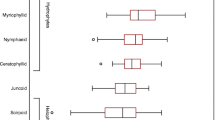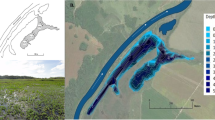Abstract
Biomass assessments of algae in wetlands usually include only the phytoplankton community without considering the contribution of other algal associations to total algal biomass. This omission prevents an accurate evaluation of the phytoplankton community as an integral part of the total ecosystem. In the present work, the biomass contributions (expressed as chlorophyll-a content per m2 of lake) of phytoplankton, epiphyton on both submerged and emergent macrophytes, and epipelon were measured in Lacombe Lake, Argentina, for the purpose of (1) establishing the relative importance of the phytoplankton and (2) evaluating the entire contribution of algal biomass within the context of the Goldsborough & Robinson conceptual model. Our sampling was carried out monthly for a year in sites representative of different conditions with respect to water depth and type of macrophytes. Physicochemical analyses of water were performed following standard methods. Plankton was collected in a five-level profile at deeper stations and in subsurface samples at the shallow one. Samples of sediment obtained with corers were collected for epipelon sampling and segments of plants were cut at different levels, so as to obtain the epiphytes by scraping. Pigment was extracted with aqueous acetone and calculations were made by means of the Lorenzen equation. According to the Goldsborough & Robinson model, a Lake State developed here during the winter (phytoplankton maxima: 150 mg chlorophyll-a per m2). Then, through the subsequent growth of the submerged macrophytes, an Open State was observed, characterized by a maximum epiphyton biomass (at 3,502 mg chlorophyll-a per m2) along with lower levels of phytoplankton biomass. The epiphytic algae on the emergent macrophytes were always present but attained only relatively low biomass values (maximum: 120 mg of chlorophyll-a per m2 in February). The epipelon biomass varied between 50 and 252 mg chlorophyll-a per m2, registering a considerable contribution of settled algae from the water column (phytoplankton). This study contributes to our knowledge of wetland dynamics through its assessment of the rapid changes in the relative contributions of both planktonic and attached algae to the total algal biomass within the context of specific environmental factors.






Similar content being viewed by others
References
Aloi, J. E., 1990. A critical review of recent freshwater Periphyton field methods. Canadian Journal of Fisheries and Aquatic Sciences 47: 656–670.
APHA, 1995. Standard Methods for the Examination of Waters and Wastewaters. APHA/AWWA/WPCF, Washington, DC.
Cano, M. G., M. A. Casco & M. C. Claps, 2003. Análisis comparativo entre taxocenosis fitobentónicas ubicadas dentro y fuera de zonas de juncal en la laguna Lacombe (Prov Buenos Aires). Boletín de la Sociedad Argentina de Botánica 38: 148–149.
Claps, M. C., M. D. Ardohain, H. Benítez, M. G. Cano, M. A. Casco, N. A. Gabellone, M. E. Mac Donagh, L. Solari & G. Ruiz, 2005. Limnological comparison of two shallow lakes (Buenos Aires, Argentina) during turbid and clear water phases. In GUI (ed.), Environmental Change and Rational Water Use Proceedings. Orientación Gráfica Ed, Buenos Aires, Argentina: 57.
Conde, D., S. Bonilla, L. Aubriot, R. de León & W. Pintos, 1999. Comparison of the areal amount of chlorophyll a of planktonic and attached microalgae in a shallow coastal lagoon. Hydrobiologia 408(409): 285–291.
Eaton, J. W. & B. Moss, 1966. The estimation of numbers and pigment content in epipelic algal populations. Limnology and Oceanography 11: 584–595.
Gabellone, N. A., R. Sarandón & C. Claps, 2003. Caracterización y zonificación ecológica de la cuenca del Río Salado. In: Inundaciones en la región pampeana. UNLP.
Goldsborough, L. G. & G. G. C. Robinson, 1996. Pattern in wetlands. In Stevenson, R. J., M. L. Bothwell & R. L. Lowe (eds), Algal Ecology: Freshwater Benthic Ecosystems. Academic Press, California: 77–117.
Guarrera, S. A., 1962. Estudios limnológicos en la laguna de San Miguel del Monte (Provincia de Buenos Aires, República Argentina) con especial referencia al fitoplancton. Revista del Museo de La Plata (NS) Botánica 9: 125–174.
Izaguirre, I. & A. Vinocur, 1994a. Algal assemblages from shallow lakes of the Salado River Basin. Hydrobiologia 289: 57–64.
Izaguirre, I. & A. Vinocur, 1994b. Typology of shallow lakes of the Salado River Basin (Argentina), based on phytoplankton communities. Hydrobiologia 277: 49–62.
Kovach, W., 2001. Multi-Variate Statistical Package (MVSP), Ver 3.12d. Kovach Computing Service, Pentraeth, UK.
Lorenzen, C. I., 1967. Determination of chlorophyll and phaeopigments, spectrophotometric equations. Limnology and Oceanography 12: 343–346.
Margalef, R., 1983. Limnología. Omega, España.
Marker, A. F. H., E. A. Nusch, H. Rai & B. Riemann, 1980. The measurement of photosynthetic pigments in freshwaters and standardization of methods: Conclusions and recommendations. Archiv für Hydrobiologie Beihefte Ergebnise Limnology 14: 91–106.
Quirós, R., A. M. Rennella, M. B. Boveri, J. J. Rosso & A. Sosnovsky, 2002. Factores que afectan la estructura y el funcionamiento de las lagunas pampeanas. Ecología Austral 12: 175–185.
Ringuelet, R. A., 1972. Ecología y biocenología del hábitat lagunar o lago de tercer orden de la Región Neotrópica Templada (Pampasia sudoriental de la Argentina). Physis 31: 55–76.
Robinson, G. G. C., 1983. Methodology: The key to understanding Periphyton. In Wetzel, R. G. (ed.), Periphyton of Freshwater Ecosystems. Dr. W. Junk Publishers, The Hague: 245–251.
Sand-Jensen K. & M. Sonderggaard, 1981. Phytoplankton and epiphyte development and their shading effect on submerged macrophytes in lakes of different nutrient status. International Revue des gesamte Hydrobiologie 66: 529–552.
Sand-Jensen, K. & J. Borum, 1991. Interactions among phytoplankton, periphyton, and macrophytes in temperate freshwaters and estuaries. Aquatic Botany 41: 137–175.
Scheffer, M., 1998. Ecology of Shallow Lakes. Chapman & Hall, London.
Solari, L. C., N. A. Gabellone, M. E. Mac Donagh & G. Ruiz, 2003a. Estructura y dinámica del fitoplancton en la cuenca de una laguna pampeana (San Miguel del Monte, Buenos Aires, Argentina). Boletín de la Sociedad Argentina de Botánica 38: 65–73.
Solari, L. C., M. E. Mac Donagh & G. Ruiz, 2002. Vertical distribution of phytoplankton in a Pampean shallow lake. Verhandlungen International Vereinigung Limnology 28: 1362–1366.
Solari, L. C., M. E. Mac Donagh & G. Ruiz, 2003b. Perfil vertical del fitoplancton en zonas de juncal y agua libre en la laguna Lacombe (Buenos Aires). Boletín de la Sociedad Argentina de Botánica 38: 165–166.
Strand, J. A. & S. E. B. Weisner, 2001. Dynamics of submerged macrophyte populations in response to biomanipulation. Freshwater Biology 46: 1397–1408.
Varela, M., 1981. El problema de la determinación de clorofila a en el fitomicrobentos: discusión sobre la metodología. Oecologia Aquatica 5: 7–19.
Yacubson, S., 1965. El fitoplancton de la laguna de Chascomús. Revista del Museo Argentino de Ciencias Naturales “Bernardino Rivadavia” e Instituto Nacional De Investigación de Las Ciencias Naturales. Serie Hidrobiología 1: 197–267.
Acknowledgments
We are very grateful to Marcelo Martínez Leanes, who kindly allowed us access to the lake in his estancia, and to Roberto Aranda for his help in the field work. Special thanks are given to two anonymous reviewers for their constructive criticism. We also wish to thank Dr. Donald Francis Haggerty, a native English speaker, for editing the final version of the manuscript. This work was funded by National Council of Sciences and Technology (CONICET) (Grant PIP 2216) and by La Plata University (Grant N343).
Author information
Authors and Affiliations
Corresponding author
Additional information
Guest editors: U. M. Azeiteiro, I. Jenkinson & M. J. Pereira
Plankton Studies
Rights and permissions
About this article
Cite this article
Cano, M.G., Casco, M.A., Solari, L.C. et al. Implications of rapid changes in chlorophyll-a of plankton, epipelon, and epiphyton in a Pampean shallow lake: an interpretation in terms of a conceptual model. Hydrobiologia 614, 33–45 (2008). https://doi.org/10.1007/s10750-008-9534-6
Published:
Issue Date:
DOI: https://doi.org/10.1007/s10750-008-9534-6




